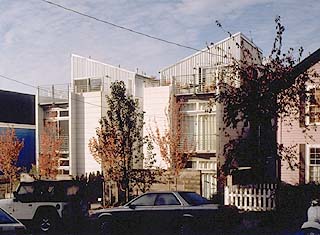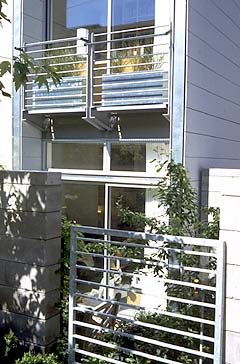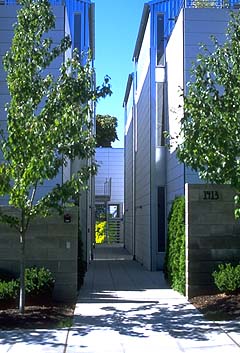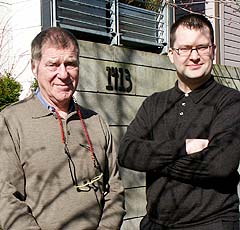|
Subscribe / Renew |
|
|
Contact Us |
|
| ► Subscribe to our Free Weekly Newsletter | |
| home | Welcome, sign in or click here to subscribe. | login |
Architecture & Engineering
| |
March 5, 2003
Nicholas Court: modern design, human scale
Special to the Journal

Photos by Clair Enlow Situated between traditional single-family homes, Nicholas Court is part of the city’s Design Demonstration Program. |
Architect Gordon Walker is invited frequently to contribute to studio critiques at the University of Washington’s architecture school. In his urban design work, Walker has concerned himself with providing distinct identities for dwellings in the city. Contemplating a student’s multi-family design project, he’s been known to ask rhetorically, "How do I find my way home?"
Walker has answered that question, very literally, in the design of Nicholas Court, a multi-family project at 15th Avenue and Madison Street, at the edge of the Central District. There, he fills the role of architect, sometime developer-client and resident.
|
Nicholas Court 1413 15th Ave. |
| Walker Architecture Owner: Better Neighborhoods LLC and Peter Erickson Project type: Market rate townhouses and condominiums Project size: 9,500 square feet Completion date: March 2001 Construction cost: $1.09 million Structural engineer: I.L. Gross Structural Engineers Electrical designer-builder: Keith Vadnais Mechanical designer-builder: The Janes Co. and Newport Plumbing Weatherproofing consultant: Exterior Research & Design Acoustical Consultant: Michael Yantis & Associates Permit expeditor: Rachel Ben-Schmuel Building code analysis: Joe Iano Energy Consultant: Patrick Hayes General contractor: Shinstine & Associates Jury comments: "This multi-family project shows a thoughtful and firm grip on combining materials. The intimacy and detailing in the exterior garden spaces and interior staircases/bookshelves show an elegant economy of means. The exterior presents an attractive front to the street, particularly when lit at night. "Assertive but comfortable fit with dense residential context. Wonderful sense of texture." "Refreshing to see a first time developer deliver a very sensitive contextual project. Creative use of materials in an otherwise traditional context. Sensitive to the street edge and surroundings." |
Nicholas Court is a carefully orchestrated ensemble of nine living units that includes studio flats along with single- and multi-level townhouses. Although they are fitted on a two-lot, 60-by-128-foot parcel, each unit has a distinct entry and a small private or semi-private open space. This minor miracle gives the entire project the feeling of a small, tightly scaled village within the city.
The site is in a vintage Seattle neighborhood, situated between two very traditional older single-family homes and across from Temple De Hirsch Sinai. But make no mistake, the residents of Nicholas Court are very much at home in the modern world. In its lines and material palette, it is very much an urban building of our time.
Walker, who created the project with his son Colin Walker -- an architect who is also a partner in Walker’s design practice -- intended to introduce something to the neighborhood and to the city.
"I wanted to build a market for something a little more contemporary," said Walker. "Most of the markets are made by real estate people, who like what they know, which is not a lot."
In Nicholas Court, Gordon Walker pursued his own long-standing interest in the possibilities of urban infill architecture and housing. Colin Walker, who joined Walker Architects in 1998 after honing his design skills in San Francisco, brought a young, urbane sensibility to the design.
The site was chosen for ease of living without a car. It’s close to bus lines and to destinations like Seattle University. And it gave the Walkers a chance to test some of the most exciting and potentially disturbing possibilities of infill architecture. Is it possible to set a new standard for modern design in close proximity to traditional buildings -- without ruining the neighborhood? Nicholas Court provides many ways to answer yes.
Nicholas Court defies easy formulas to evaluate the term "contextual." Its height, bulk and scale push the limits of the zoning code. The industrial materials and geometric grid contrast starkly with the two-story, peaked-roof, clapboard houses on either side.

In the modernist spirit, the glass is set into full-height openings. |
In addition to resetting the uneven rhythm of a single and multi-family residential neighborhood, Nicholas Court's real contribution lies in its ability to bring human scale and distinct identities to contemporary multi-family units. It also helps to redefine the meaning of open space, light and air -- all basic needs that drive set-back and open space requirements in the code.
The project that became Nicholas Court was first seen in 1998 in the Design Demonstration Program, a juried collection of architect-designed urban infill projects that would not have been permissible under Seattle zoning at that time. The purpose of the program, a cooperative venture between city of Seattle and a group of local architects, was to show the way toward small-scale design that appeals to owner-occupants and neighborhoods while helping achieve greater density in the city. Nicholas Court was one of 20 projects picked for the program, which allowed it to breeze through a neighborhood design review process that would have stopped it -- based in part on its slanted roof lines and unusual approach to height calculations.
The intricate network of common and private outdoor space inside Nicholas Court required pushing the envelope of the building to the outer limits. At the same time, it established a more urban armature along the street, one that helps to consolidate a very mixed corridor that includes single family, multi-family and institutional buildings.
A head-high cinder block wall in front provides a strong boundary and clear entrance. It breaks in the center, opening to a passage that leads to the inner courtyard. The courtyard of Nicholas Court is not a passive open space but a busy, multi-level circulation area, with front doors on two levels and old-fashioned mail boxes ranked along a rail.

A cinder block wall provides a boundary to the inner courtyard. |
Three townhouses, three small one-level flats, one large mega-flat and two two-level units are fit around the courtyard, and most entrances are visible there. In plan, the open space at street grade is cruciform, with the courtyard at the center and units grouped in four clusters, connected above with walkways and landings.
Cars are out of sight at Nicholas Court, tucked beneath the complex in underground parking. But even the driveway is exploited for special urban effects, with the small balcony of one unit positioned, village-style, over the pavement dipping down to the garage.
Signatures of modernist sensibility are everywhere at Nicholas Court -- industrial elements and cheap, conventional materials exploited for visual effect and utility.
Cement board -- laid horizontally with small breaks in between the boards -- is attached with breathing space outside the European-manufactured moisture barrier. The system provides depth and bold detail to exterior surfaces while promising a long-lived exterior.
The interiors are tightly orchestrated to receive natural light and capture views. In the spirit of early modernism, the glass is set into full-height openings that emphasize views of the street and the city skyline. In another modernist move, windows meet outer walls at right angles without returns. In this way, the flow of space between interior and city is unhampered.

Gordon and Colin Walker |
The Walkers have perfected the modernist character of Nicholas Court in the careful cutting and shaping of kitchen cabinetry, stair steps, shelving and doors. They are all made of particle board, coated with a clear finish or painted.
For his own home in the city, Gordon Walker went a step further, adding clear-finished particle board floors. And even though his unit faces 15th Avenue and gets no southern light, he has his own special slice of his hometown. On the third level, a tall, narrow window looks out from a small return in the building envelope, perfectly framing the Space Needle.
The Project of the Month feature is sponsored by the Daily Journal of Commerce and the Seattle chapter of the American Institute of Architects. The Project of the Month for March, Nicholas Court, by Walker Architecture, was selected with the assistance of architects Peter Hockaday, Marilyn Brockman and Bill Fuller; and developer Val Thomas. For more information about submitting projects for possible feature articles, contact Peter Sackett at AIA Seattle, (206) 448-4938, or psackett@aiaseattle.org.
Clair Enlow can be reached by e-mail at clair@clairenlow.com.
Previous columns:
- 505 Union's ambitious design is worthy of a tycoon, 02-05-2003
- 2002 Projects of the Month defy the predictable, 01-08-2003
- LMN's Redmond bridge turns mundane into magical, 12-04-2002
- Transparent design helps keep commuters moving, 11-06-2002
- Breaking out of the box, Northwest style, 10-02-2002
- At BCC, a study in sustainable design, 09-04-2002
- A retreat for teens ends decade-long run-around, 08-07-2002
- A once lackluster hall now scans the heavens, 07-03-2002


